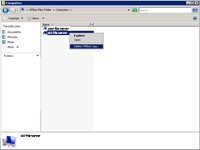
(Enlarge)
|
- The first false assumption was that of going to Offline Files and deleting the offline copy. That did not remove the disconnected file server's cached files on the web server.
|

(Enlarge)
|
- The second false assumption was interpreting Microsoft Documentation regarding the Desktop Experience (here) in that it would help manage, aka "delete", the offline files.
- The Desktop Experience - to get Sync Center - (in hindsight) was of no use and if you install it you get some "bonus" applications installed as well such as Windows Defender.
- With the Desktop Experience installed, it was investigated to see if it could do the trivial task of removing the disconnected file server's cached files on the web server.
|

(Enlarge)
|
- Sync Center allows you to see the offline files but there's no way to get rid of the disconnected file server.
|

(Enlarge)
|
- So, let's go back to the Offline files pane and disable offline files. The assumption here is, might as well purge all of it and rebuild only what is current.
|

(Enlarge)
|
- Why look, now the server has to be rebooted; good thing it was taken out of the cluster just incase a reboot was needed.
|

(Enlarge)
|
- After server reboot and going back to the offline files pane, it shows that there's no offline files. Could this be it?
- I enable offline files.
|

(Enlarge)
|
- Sync Center shows that there's no offline files. Could this really be it?
|

(Enlarge)
|
- Let's go back to the offline files pane. It says offline files are enabled but not active so a reboot is needed. Let's reboot again. I love rebooting servers.
|

(Enlarge)
|
- Why look there! Oh, wait. All the offline files I had falsely assumed where gone are still there. It would seem that getting rid of offline files is like trying to get rid of a dark fungus.
|
|
OLD SCHOOL
|
- It's time to shift thinking to "old school".
- Did a lot of research and found there is a handy command-line tool called csccmd.exe available with Windows Server 2003 here. Since we're shooting in the dark here, let's download it and see if it will work.
- As suspected, that tool (for x32) would not work on Windows Server 2008 x64. Well, at least there's a piece of software to add to the archive incase I need to deal with an ancient Windows Server 2003 system.
- Found some good documentation for csccmd.exe that you can read here.
- Also found some documentation on modifying the registry from the command-line you can read here.
|
|
OLD SCHOOL
|
- A little more "old school" thinking lead to locating the offline files location on the hard drive of the web server. Surely the files could be deleted or modified.
- The offline files physical location was found at c:\windows\csc\Server-Share-Namespace. Unfortunately you will not be able to do anything without some "changes" to the server being done.
|

(Enlarge)
|
- Time to bust directly into the registry. Good thing the server has been removed from the cluster. I've got a feeling that the server will have to be rebooted. At least once.
- Would hate to make a mistake here and lock up the entire server so it becomes an expensive paper weight.
|

(Enlarge)
|
- Let's make a new entry under "Computer\HKEY_LOCAL_MACHINE\SYSTEM\CurrentControlSet\Services\CSC\Parameters" called "FormatDatabase".
|

(Enlarge)
|
- Now modify that new entry.
|

(Enlarge)
|
- Now modify that new entry so it has the value of 1.
- And, reboot the server. Did I mention I love rebooting servers all the time?
|

(Enlarge)
|
- After reboot, let's look at offline files.
- Then, looking at "View your offline files" it only shows the new file server.
|

(Enlarge)
|
- Drilling down reveals that nothing is actually being cached (although offline file sharing is enabled on the new file server). This is okay.
|

(Enlarge)
|
- Open file explorer and navigate to the folder on the new file server.
- Right click and select "Always Available Offline".
|

(Enlarge)
|
- The icon on the folder should indicate it has been set for offline files.
|

(Enlarge)
|
- Let's go back to the offline files pane and click "View your offline files".
|

(Enlarge)
|
- Why look! The files off of the new file server are, indeed, in place.
- Now it's time to put the server back into the cluster.
|


















